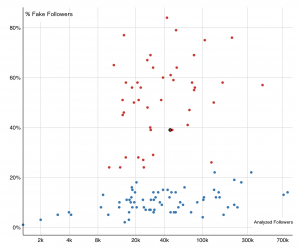The Swiss state TV SRF made an extensive analysis [German] of the followers of the top Influencers in Switzerland. The study analyzed over 7 million followers of 115 Swiss Instagrammers. 16% resulted to have more than 50% of fake followers, while 80% of them had less than 30%.

Fake Instagram Followers Distribution Switzerland – Source: SRF
The study used a statistical learning model, which has been trained with a dataset of 1000 Instagram accounts that have been manually labelled as fake or real. The accounts have been classified as fake or real based on series of variables like: total amount of followers, total amount of accounts this account is following, total number of media this account has posted, whether a profile picture has been set, whether the account is private, whether the user has a number in the username, the ratio of alphabetic letters in the username and ratios of number of users following to followers, number if users following and number of posts, number of followers to posts.
This is analysis is providing interesting insights into the spread of fake followers. It train a statistical learning model that is able to predict whether an Instagram account is fake or not with very high precision. It provided a methodical method to classify Instagram users. Of course the definition of “fake” can be open for discussion. The researchers team definition of “fake” is not definite and exact, it depends mainly on human intuition. More research is needed in order to find a generally accepted definition of fake.
